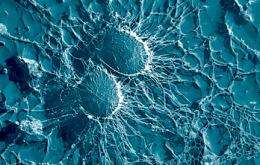Scientists trick bacteria with small molecules

(�鶹��ԺOrg.com) -- A team of Yale University scientists has engineered the cell wall of the Staphylococcus aureus bacteria, tricking it into incorporating foreign small molecules and embedding them within the cell wall.
The finding, described online in the journal ACS Chemical Biology this week, represents the first time scientists have engineered the cell wall of a pathogenic “Gram-positive” bacteria—organisms responsible not only for Staph infections but also pneumonia, strep throat and many others. The discovery could pave the way for new methods of combating the bacteria responsible for many of the most infectious diseases.
The team engineered one end of their small molecules to contain a peptide sequence that would be recognized by the bacteria. In Staphylococcus aureus, an enzyme called sortase A is responsible for attaching proteins to the cell wall.
“We sort of tricked the bacteria into incorporating something into its cell wall that it didn’t actually make,” said David Spiegel, a Yale chemist who led the study. “It’s as if the cell thought the molecules were its own proteins rather than recognizing them as something foreign.”
The scientists focused specifically on the cell wall because it contains many of the components the cell uses to relate to its environment, Spiegel said. “By being able to manipulate the cell wall, we can in theory perturb the bacteria’s ability to interact with human tissues and host cells.”
The team used three different small molecules in their experiment — including biotin, fluorescein and azide — but the technique could be used with other molecules, Spiegel said, as well as with other types of bacteria. Another advantage to the new technique is that the scientists did not have to first genetically modify the bacteria in any way in order for them to incorporate the small molecules, meaning the method should work on naturally occurring bacteria in the human body.
Staph infections, such as the drug-resistant MRSA, have plagued hospitals in recent years. More Americans die each year from Staphylococcus aureus infections alone than from HIV/AIDS, Parkinson’s disease or emphysema.
Being able to engineer the cell walls of not only Staphylococcus aureus but a whole family of bacteria could have widespread use in combating these illnesses, Spiegel said, adding that any number of small molecules could be used with their technique. “For example, if we tag these bacteria with small fluorescent tracer molecules, we could watch the progression of disease in the human body in real time.” The molecules could also be used to help recruit antibodies that occur naturally in the bloodstream, boosting the body’s own immune response to diseases that tend to go undetected, such as HIV/AIDS or cancer.
“This technique has the potential to help illuminate basic biological processes as well as lead to novel therapeutics from some of the most common and deadly diseases affecting us today,” Spiegel said.
More information: Research paper:
Provided by Yale University
















